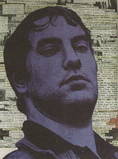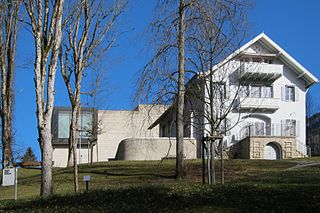
Rolf Dieter Brinkmann was a German writer of poems, short stories, a novel, essays, letters, and diaries.

Hugi is one of the longest-running and most frequently released demoscene and underground disk magazines (diskmag) for IBM-PC.

Ludwig Meidner was a German expressionist painter and printmaker born in Bernstadt, Silesia. Meidner is best known for his painted, drawn, and printed portraits and landscapes, but is especially noted for his "apocalyptic" series of work featuring his stylized visions of a pending transformation of Germany before World War I.
Muntean/Rosenblum is a collaborative artist duo composed of Markus Muntean and Adi Rosenblum. They have been collaborating since 1992.

Franz Gertsch was a Swiss painter and printmaker who was known for his large format photorealistic portraits and detailed studies of nature.
Jolyon Brettingham Smith was a British composer, conductor, performer, author, and radio presenter, and a university teacher at the Berlin University of the Arts.

Mercedes Bunz is a German art historian, journalist, and the Professor of Digital Culture and Society at King's College London.
Xenia Hausner is an Austrian painter and stage designer.

The Museum of Islamic Art is located in the Pergamon Museum and is part of the Staatliche Museen zu Berlin.
Natascha Drubek-Meyer (Drubek) is a researcher, author and editor in the area of Central and East European literature, film and media. Since 2012 Drubek has been teaching comparative literature, and film and media studies, at the Free University of Berlin (in 2020-21 as professor of the FONTE-Stiftung].

Ida Gerhardi was a German Neo-Impressionist painter who spent much of her career in Paris.
Elias Wessel is a visual artist living and working in New York and Germany.

Wolfgang Ernst is a German media theorist. He is Professor for Media Theories at Humboldt University of Berlin and a major exponent of media archaeology as a method of scholarly inquiry.
Emmy Lischke (1860-1919) was a German painter known for her landscapes and still lifes.

The Franz Marc Museum is a museum located in Kochel am See, Upper Bavaria, dedicated to German Expressionist painter Franz Marc. The museum shows paintings by Franz Marc, and also works of art of his contemporaries and other important artists of the 20th century, in a permanent and in temporary exhibitions.

The Kulturverlag Kadmos is a non-fiction and fiction publishing house founded in Berlin in 1995.
Anke te Heesen is a German historian of science and professor for the History of Science at Humboldt-Universität zu Berlin. Her research focuses on the development and organization of knowledge in the 19th and 20th centuries.
Robert Suckale was a German art historian, medievalist and professor at Technische Universität Berlin.
Jeong-hee Lee-Kalisch is a South Korean art historian specialising in Chinese painting and archaeology, Korean art, Buddhist art and East Asian ceramics. From 2003 to 2021 she was the Professor of East Asian Art History in the Art History Institute at the Free University Berlin.
Georg Ludwig Kinsky was a German musicologist.



















